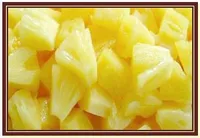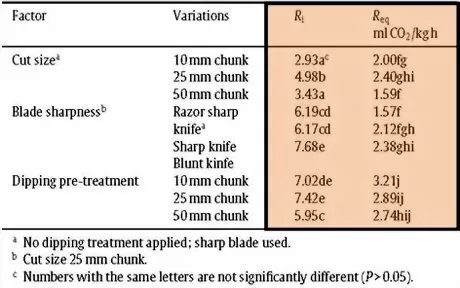 Irish scientists have investigated the effect of intrinsic factors (origin, ripening stage, and growing season) and extrinsic factors (cut-size, blade-sharpness and dipping treatments) on respiration rate (RCO2) of fresh-cut pineapple chunks. They developed a mathematical model for the respiration based on exponential decay, the initial respiration rate (Ri) and equilibrium respiration rate (Req) were the model parameters that were found fundamental to assess the effect of intrinsic and extrinsic factors on respiration rate.
Irish scientists have investigated the effect of intrinsic factors (origin, ripening stage, and growing season) and extrinsic factors (cut-size, blade-sharpness and dipping treatments) on respiration rate (RCO2) of fresh-cut pineapple chunks. They developed a mathematical model for the respiration based on exponential decay, the initial respiration rate (Ri) and equilibrium respiration rate (Req) were the model parameters that were found fundamental to assess the effect of intrinsic and extrinsic factors on respiration rate.The initial rates were affected by raw material and processing severity, furthermore the respiration rate increased by increasing the fruit ripening. Fresh-cut pineapple chunks showed a gradual decline in respiration rate. Immediately after cutting, the respiration rate was very high, but it decreased and stabilized within 24 hours. The average values of initial respiration rate and equilibrium respiration rate were 8.52 and 2.64 ml/kg h, respectively. As regards the effect of intrinsic factors on respiration rate (Table 1), Ri was affected to a greater extent by physiological age and origin than by season.
Table 1. The effect of intrinsic factors on respiration rate of fresh-cut pineapple at 4°C. Clicca qui per un ingrandimento della tabella.

As regards the effect of external factors on respiration rate (Table 2), cut size effected Ri and Req, the lowest values (5.9 and 2.7 ml/kg h, respectively) were obtained by larger pieces, while the highest values (7.0 and 3.2 ml/kg h, respectively) were obtained by the smallest pieces.
Table 2. The effect of extrinsic factors on respiration rate of fresh-cut pineapple at 4°C.

Considering the respiration rate variability, the predicted range of O2 and CO2 was found to be 12.3-16.2% and 5.1-9%, respectively after 7 days at 4°C. The scientists estimated the target barrier properties for packaging 150 g of fresh-cut pineapple chunks. The recommended modified atmosphere was 6% O2 and 8% CO2, and the target of O2 transmission rate (OTR) and CO2 transmission rate (CTR) required to reach an equilibrium within the recommended atmosphere range was found to be 7,300-12,500 and 13,900-23,500 ml/m2 day atm, respectively for 25.4 µm of film thickness.
Source: Finnegan E., Mahajan P.V., O'Connell M., Francis G.A., O'Beirne D., "Modelling respiration in fresh-cut pineapple and prediction of gas permeability needs for optimal modified atmosphere packaging", Postharvest Biology and Technology, 2013, 79: 47-53. Further info: http://www.sciencedirect.com/science/article/pii/S0925521412002815#
